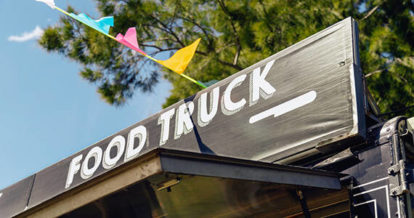While changing COVID-19 restrictions forced many restaurants to lean on takeout and delivery throughout the winter months, warmer weather means the return of a valuable revenue source: outdoor dining. As summer approaches, reopening your restaurant patio for outdoor dining can be the perfect way to start welcoming diners back and begin recovering lost revenue.
For restaurants, now’s the time to start making plans for restaurant recovery and return of outdoor dining, including purchasing restaurant patio furniture, hiring staff, refining safety protocols, and more.
This guide to reopening your restaurant patio for outdoor dining will help you prepare by teaching you:
- The benefits of offering outdoor restaurant seating service
- 5 tips to prepare your restaurant patio for reopening
- How to maintain your outdoor dining space
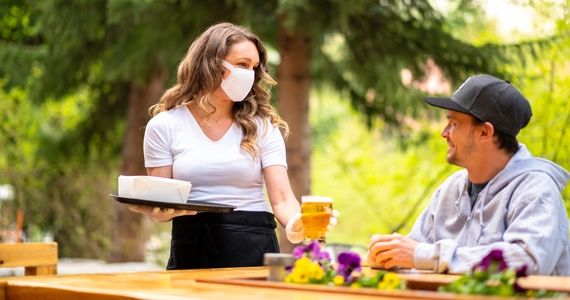
3 Benefits of Restaurant Patio Dining
With the COVID-19 pandemic still lingering, outdoor dining is still a better, safer option than serving customers in an enclosed dining room, and it offers other benefits as well.
1. Outdoor dining is a less risky alternative to indoor dining. When it comes to the question “is outdoor dining safe?,” the answer is that patio dining is generally safe when all the proper safety protocols are being followed. Because outdoor spaces tend to be better ventilated and less crowded than indoor spaces, experts say restaurant patios are less risky (though some risks do still remain).
2. Patio dining can ease customers’ anxieties about going to restaurants. A 2020 survey by the online publication Slate found that 36% of respondents said they would eat at a restaurant outdoors, while only 15% said they would eat at a restaurant indoors with reduced seating. And a recent study by Constant Contact found that 21% of customers wanted outdoor dining to continue, even after the pandemic subsides.
3. Outdoor dining presents an opportunity for restaurants to maximize revenue. In areas where indoor dining may still be recovering, patio dining lets you regain full service dining as a revenue stream. And even if your dining room is fully packed, operating a restaurant patio can boost your total by up to 30%.
While there are many benefits to outdoor dining, keep in mind that you’ll need a permit or license in order to operate a restaurant patio.
Fortunately, many cities have made it easier for restaurants to get permits for outdoor dining by simplifying applications, expediting approvals, waiving fees, and allowing new rules. Toronto’s CaféTO program, for example, is an initiative that helps restaurants apply for sidewalk and curb dining. And last year, some cities even closed down entire streets to create new spaces for outdoor dining.
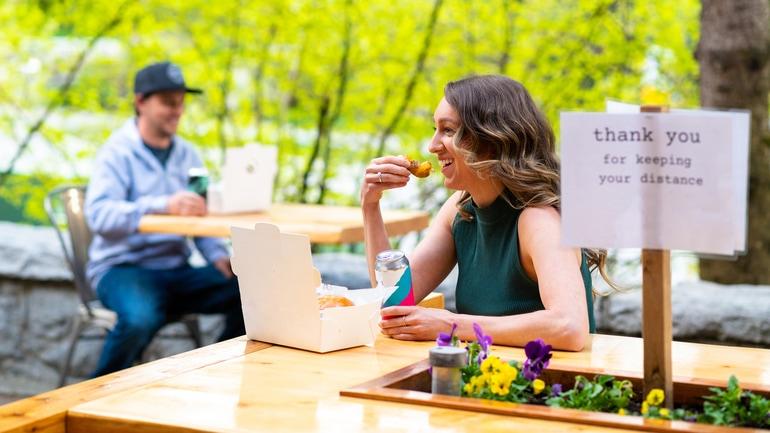
5 Steps to Prepare Your Restaurant Patio for Reopening
Once you’ve gotten the proper legal permits, you’re ready to start preparing your outdoor dining space. Here’s how to get ready for your restaurant patio reopening.
1. Prepare the physical space
Use these restaurant patio ideas to create a space that keeps your guests and staff safe at all times.
If you’re launching outdoor dining for the first time, you may have to purchase outdoor dining furniture. If you have a choice, you might want to choose wooden or plastic outdoor furniture over metal, since some research shows that the coronavirus survives the longest on metal surfaces.
You’ll also need to consider diner comfort and set up your tables accordingly. Move tables so that they’re at least six feet apart, if not more, to promote social distancing. If your patio has bar seating, you could remove the bar and its stools to make room for tables. Then, update your floor plan management tool to reflect your new outdoor restaurant seating arrangements.
Your next consideration is overhead coverage. Before you put a tent up around your patio, check out local regulations. Some areas, like Parkland, Florida, require restaurants to obtain permits to put up tents. Others allow tents but only if they aren’t enclosed, like in Baton Rouge, Louisiana. No matter what type of tent you install on your patio, make sure that it doesn’t reduce air circulation.
Next, create dedicated entrances and exits to your restaurant patio to prevent unnecessary foot traffic. Add social distancing signs and directional arrows on the floor with tape to ensure that guests know where to go.
Finally, if you have space to safely create a waiting area, put signs on the floor to mark off 6-foot wide spaces between customers. For a more seamless process, implement a digital waitlist through your reservation software or standalone app so that customers can wait to be seated from the safety of their cars, or away from the queue.
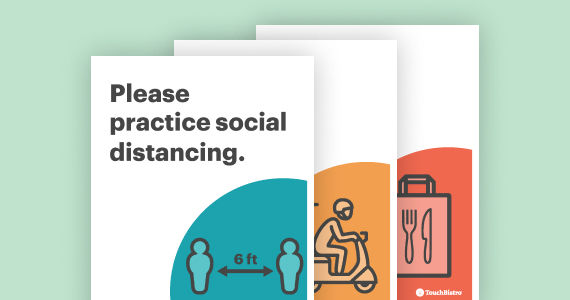
Remind staff and customers to keep their distance with our free social distancing signs for restaurants.
2. Develop protocols
Even if restrictions have been fully lifted in your area, maintaining some safety policies and procedures can make customers feel more confident about dining with you. Consider maintaining or adjusting the following protocols.
- Remove shareable items: Swap out your reusable menus for paper menus that you can dispose of after parties use them, or go digital with QR code menus. Switch communal condiment bottles out for single-serving packets, or pour them into condiment cups and give them to customers on request.
- Reservations: Consider implementing a reservations-only policy. Reservations can help your staff maintain capacity, prepare for service, and create downtime between outdoor restaurant seatings for increased safety. See how TouchBistro’s restaurant reservation system integrates seamlessly with your POS and makes it easier for you to welcome back guests safely and efficiently.
- Develop a cleaning schedule: Your restaurant’s pre-pandemic cleaning protocol isn’t going to cut it anymore. Develop a new restaurant cleaning process and schedule that ensures high traffic areas are cleaned often. You should also make sure staff know how to clean a credit card reader and other high-touch restaurant technology.
Inform your customers about these protocols on your restaurant’s website, on menus, and on signs around your restaurant and patio. Telling customers about the safety measures you’re taking will ease apprehensions they may have about going dining out.
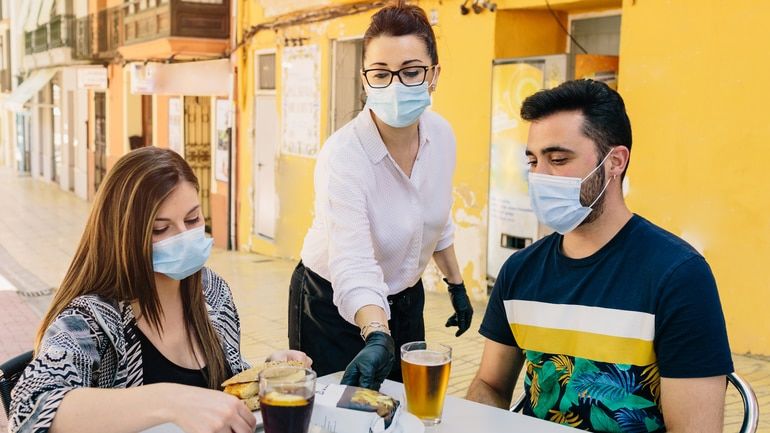
3. Train staff
Training staff members on your new safety measures is crucial, because they’ll be the ones to carry them out and ensure their success.
Some restaurants have developed new training programs for staff either coming back from furlough or those that are newly hired. These programs should include how to:
- Clock in and out of the POS properly, so you always have a record of when and where staff worked (in case required for contact tracing).
- Use new technology if you’ve acquired to adapt your business. This could include QR code menus, reservations software, contactless payment terminals, and tableside ordering with the POS.
- Take orders and serve food while social distancing (e.g. where to stand at tables, which side of approach, etc.) to keep diners comfortable.
- Minimize contact with other employees, using specific workstations in the kitchen and a flow to move around the restaurant.
- Avoid unnecessary handling of food and dishware (e.g. no passing off plates, no adding garnishes without gloves, no touching glassware when refilling, no packing takeout/leftovers, etc.).
- Wipe down and disinfect tables after every use, using approved hard-surface cleaning materials and paying attention to key touch points
- Maintain frequent handwashing throughout a shift, using the correct technique, and avoid touching the face and mouth at all times.
- Wear gloves when necessary, ensuring they know when to change them (frequently), how to take them off, and how to discard them.
- Wear masks properly (the Occupational Safety and Health Administration still recommends them) from the entire nose down to the chin. Masks should fit snugly on the sides. Even if masks are no longer required in your area, it’s a good idea to take extra precautions in this industry. The Journal Inquirer has a great illustration that shows the do’s and don’ts of mask wearing.
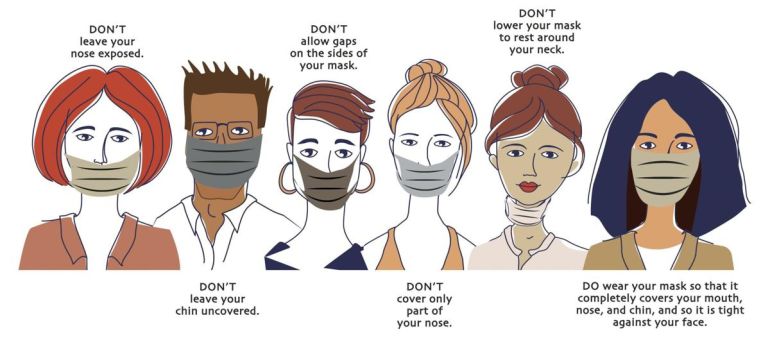
Image source: Hollister Breslin
4. Communicate with customers
When you’re ready to welcome customers back for outdoor dining, make sure they know about your patio reopening by ramping up your restaurant marketing efforts – especially if you’re going to be open for major summer holidays like July 4th. Spread the word through social media, email, and your Google listing.
In your communications with customers be sure to drum up exciting offerings like a dedicated patio menu, but also include new rules and safety procedures in these announcements so that customers know you’re committed to offering a safe restaurant patio experience. You can also assuage their fears by answering questions like “is outdoor dining safe?” right off the bat.
Post signage around your outdoor dining space to remind customers to maintain a safe distance from others and wear masks (if still required) before being seated and when entering the restaurant to use the restroom. Train your staff to enforce these safety measures to create a safe restaurant patio environment for all.
5. Create a plan for poor weather
Unfortunately, when dining outdoors, your customers will be susceptible to the elements.
In the case of rain, determine whether it would be feasible for you to move customers inside. If that’s not an option, create a plan to quickly wrap up customers’ food to go. Consider putting large patio umbrellas on tables, as long as they don’t create an enclosed space.
If you’re in an area that is susceptible to intense heat, think twice before setting fans up outside. While a natural breeze isn’t concerning, fans cause air turbulence that can disrupt the dining experience. Consider closing patio service if temperatures get too high.
How to Safely Manage Your Restaurant Patio Dining Service
So you’ve done all you can to prepare your space, your staff, and your customers for restaurant patio dining. But once you reopen your patio, the work has only just begun. Stick to the procedures below to ensure you’re managing your patio dining service safely.

Maintain physical distancing
Staff and groups of customers should maintain a distance of six feet or two meters apart from each other at all times, including while waiting for a seat, while seated, and while taking orders.
Reinforce the importance of maintaining this distance to staff during your training. Encourage staff to hold each other accountable by calling each other out if they get too close.
Manage reservations
Your reservations tool can help you seat customers safely and efficiently. Space apart seating times to allow for cleaning between parties. For example, if your average table turnover time is one hour and 45 minutes, block out tables for two-hour intervals to make time for cleaning.
If your space is limited and reservations are popular, you may have to create a time limit on tables. Thoroughly communicate this point to customers so that the policy doesn’t take them by surprise. Let them know about the time limit both when they make the reservation, and when you seat them. Train staff to politely enforce outdoor restaurant seating time limits.
Maintain hygiene
Maintain high cleanliness standards for staff and surfaces.
Even as more staff and customers are vaccinated, proper hygiene should still be a top priority on restaurant patios. Front-of-house staff should maintain personal hygiene by washing hands frequently and staying home if they don’t feel well. Food handlers should wear masks at all times and obey social distancing in the kitchen.
Check the FDA’s website for the most up-to-date guidelines about food safety amid the pandemic. If you create a checklist for your cleaning policy, enforce it by requiring staff to sign off each time they’ve completed it.
Track data to manage costs better
If you had an idea of your food and labor cost percentage before the pandemic, those figures are probably no longer applicable to the current situation. Keep a close eye on POS reports around your restaurant patio reopening. This data can give you accurate information on food and labor costs to help you adjust your budget and spending.
You could even use this information to adjust the prices of your menu items.
Market your restaurant patio reopening
Use targeted restaurant marketing strategies to maximize the buzz and revenue generated from your patio reopening.
Consider creating new menu items or even a dedicated patio menu to celebrate the return of patio season. Frozen mocktails, for example, are festive, easy to create, and Instagram-worthy.
If possible, extend your restaurant’s hours. If you’re a dinner-only restaurant, consider creating a new brunch menu. If you’re a breakfast and lunch spot, open up for dinner, too. Extending your hours and creating a dedicated patio menu will help maximize revenue and let customers experience your restaurant in a new way.
Once you’ve come up with some creative restaurant patio ideas for your venue, reach out to the local press to share the promotions that your restaurant is introducing for its patio reopening.
Even with the end of the pandemic in sight, outdoor dining gives restaurants that have been closed, or working in a diminished capacity, an opportunity to start welcoming customers back and make up for lost revenue. With the right safety measures and tech in place, restaurant patio dining can be a fruitful opportunity for your business. Learn how TouchBistro can equip your restaurant with the tools for a successful outdoor dining service.
Download our free inventory template
Sign up for our free weekly TouchBistro Newsletter




